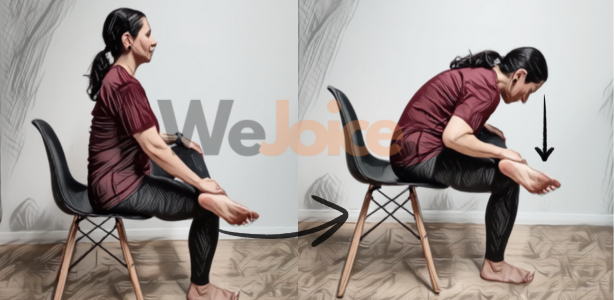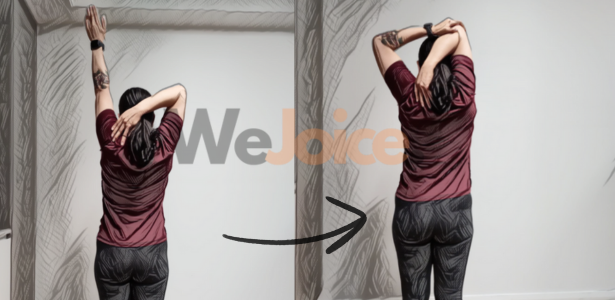5 Stretches to Improve Health
- Christina

- Oct 14, 2023
- 6 min read
Updated: Dec 23, 2023
Learn about the benefits of gentle stretching and how to incorporate them into your daily routine for improved health and well-being.

Stretching is often overlooked or regarded as less important when it comes to fitness and staying youthful. However, it plays a crucial role in maintaining flexibility and mobility. As we age, our joint range of motion frequently suffers due to muscular tightness.
This tightness happens when our muscles get tense for various reasons.
Sometimes, it can happen because our muscles have adapted to a particular posture or because of scar tissue. Other times, it can occur because our muscles are spasming or contracting. Regardless of why it happens, muscle tightness can limit how far we can move our joints and even lead to an imbalance in our muscles.
When it comes to stretching, there's usually an opposite relationship between muscle tension and muscle length. If our muscles are less tense, they can become more prolonged; if they are tense, they become shorter.
What are the benefits of stretching for people aged 55+?
Enhanced Everyday Life: Daily tasks like driving, carrying groceries, or doing laundry become more manageable when your body can move without discomfort or restriction.
Less Lower Back Pain: Regular stretching can help reduce pain, especially in the lower back and sciatic region, by increasing flexibility in your hip flexors, hamstrings, glutes, and pelvic muscles.
Better Posture: Stretching your neck, shoulders, back, and chest can improve spine alignment, resulting in better posture.
Reduced Risk of Injury: Well-stretched muscles are less prone to injury during sudden or abrupt movements, reducing the risk of falls or strains.
Improved Range of Motion: Flexible joints can move more freely, requiring less energy. Stretching may also slow down the natural process of joint wear and tear.
Improved Blood Circulation: Stretching muscles improves blood circulation, ensuring your muscles and joints receive all necessary nutrients.
Type of stretches:
There are three different types of stretching. Static usually works best in the cool-down phase after exercising, whereas dynamic stretching can be performed as a warm-up prior. However, ballistic stretching is no longer considered a safe practice and should be avoided.
Static Stretch
The most traditional and widely practiced type of stretching is static stretching. A particular position is assumed in static stretching, and the muscle is held in a state of tension until a stretching sensation is felt. This position is then typically repeated. Static stretching can be executed either passively with the assistance of a partner or actively by the individual themselves.
Dynamic Stretch
Dynamic stretching comprises two main types: active stretching and ballistic stretching. Active stretching typically involves moving a limb smoothly through its entire range of motion, reaching the endpoints, and repeating this motion several times.
Ballistic Stretch
On the other hand, ballistic stretching used to involve rapid, bouncing movements at the end of the range of motion. However, due to its elevated risk of causing injuries, ballistic stretching is no longer recommended.
Gentle stretching exercises for people aged 55+:

SEATED PIRIFORMIS STRETCH:
Begin by positioning yourself at the front edge of your chair. Cross your left leg over your right leg.
Maintain an upright posture with your back straight. Gently lean forward, but only as far as feels comfortable for you.
Hold this stretch for a duration of up to 30 seconds.
Now, switch to the opposite side and repeat the stretch.
This exercise is beneficial for alleviating lower back and hip discomfort and can also provide relief from sciatic pain.

CHEST STRETCH:
Stand or sit up straight with your shoulders relaxed.
Extend your arms straight in front of you, ensuring your thumbs are pointing upward.
Keep your arms straight as you move them outward and backward, maintaining them parallel to the floor.
Hold this stretch for up to 30 seconds, then repeat as desired.
This exercise helps to open up your chest and shoulders, promoting improved posture and reducing slouching.

TRICEPS STRETCH:
Maintain an upright posture while standing or sitting, engaging your core muscles.
Raise your left arm above your head, fully extending it upward.
Bend your left arm at the elbow, keeping your elbow pointed upward.
Use your right hand to gently pull your left elbow towards the right side of your body.
Hold this stretch for up to 30 seconds, then release slowly.
Switch sides and repeat.
This stretch is effective for loosening arm muscles and increasing shoulder mobility.

NECK STRETCH:
Stand or sit with your back straight and feet flat on the floor.
Tilt your head to the left, bringing your left ear closer to your left shoulder, only as far as it feels comfortable.
Reach over your head with your left hand and gently pull your head toward your left shoulder.
Hold this stretch for up to 30 seconds, then release gradually.
Switch sides and repeat.
This stretch improves neck mobility, which is particularly useful for checking blind spots while driving.

HAMSTRING STRETCHES:
Standing:
Stand up straight with your feet shoulder-width apart.
Extend your right foot out in front of you while bending your left leg.
Slowly hinge at the hips and place your hands on your right upper thigh. Gently apply downward pressure.
Hold this stretch for up to 30 seconds.
Switch sides and repeat.
Seated:
Sit at the edge of your chair and extend your right leg in front of you, keeping your heel on the floor.
Slowly reach forward, hinging at your hips while maintaining a straight back.
Hold this stretch for up to 30 seconds.
Switch sides and repeat.
These stretches increase hip flexibility and help maintain mobility for everyday tasks like bending and climbing stairs.
Incorporate stretching into daily life
Regardless of age or fitness level, the overall benefits of stretching are undeniable. It is never too late to start a new routine to improve your overall health and stay youthful. However, it might be hard to pick up a new routine and be consistent, especially when you start. If you struggle to make a new routine stick, read our article how you can create a long lasting new habit and consider implementing it as part of your daily routine.
Stretching when waking up or before going to bed
Performing stretches first thing in the morning will get your heart pumping and thus can help to improve blood circulation to wake up your body.
When watching TV
Stretching can easily be combined with watching TV. There is no reason not to do both simultaneously and increase time efficiency to truly multitask. It doesn't have to stop there; you can stretch while on the phone or brushing your teeth, basically whenever you stand idle while waiting on something.
After workout
If you already do workouts, good on you! Keep doing them and extend them with some stretching exercises to finish off. Your muscles would already be warm, which helps you to stretch further than in a cold state.
Yoga or Tai Chi classes
Consider taking Yoga or Tai Chi classes. Not only can they be fun and encouraging, but they also allow social interactions crucial to staying socially engaged. It's just more fun to exercise in a group than by yourself. For both Yoga and Tai Chi, stretching is an integral part of their exercises. If you have never heard of either, Yoga is a holistic practice originating from India that combines physical postures, breathing exercises, and meditation to promote physical and mental well-being. It focuses on flexibility, strength, and inner peace.
Tai Chi is a Chinese martial arts practice emphasizing slow, flowing movements and deep breathing. It promotes balance, relaxation, and improved energy flow throughout the body, often practiced for its health benefits and stress reduction.
How often should I stretch?
For a general fitness regimen, the American College of Sports Medicine suggests incorporating static stretching into the routine for most individuals, following an active warm-up, on at least 2 to 3 days per week. It is recommended to hold each stretch for 15-30 seconds and repeat it 2 to 4 times. However, adults over 65 may require longer stretch durations than the recommended 15 to 30 seconds. Researchers indicate that holding static stretches for 60 seconds was associated with more significant improvements in hamstring flexibility compared to shorter duration holds.
Static stretching of the trunk muscles for ten weeks can improve spinal mobility in adults over 65. Static hip flexors and extensor stretching may also improve gait in older adults. Overall, static stretching seems to be better for women and adults over 65 than other types of stretching.
Whether you just started or are an expert in stretching, consistency is one of the most important things. Results show slowly over time. Expect several weeks to months of regular stretching exercise before you can expect some improvements.
And as usual, before beginning a new exercise routine, seeking advice from a medical professional is essential. If you have muscle or joint injuries or a history of surgeries, consult your doctor or physical therapist to determine the most suitable stretches for your condition.
Avoid stretching to the extent where you experience pain, and remember not to hold your breath while performing stretches.




Comments